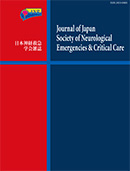30 巻, 2 号
選択された号の論文の14件中1~14を表示しています
- |<
- <
- 1
- >
- >|
原著論文
-
2018 年 30 巻 2 号 p. 1-8
発行日: 2018/06/01
公開日: 2018/11/15
PDF形式でダウンロード (957K) -
2018 年 30 巻 2 号 p. 9-13
発行日: 2018/06/01
公開日: 2018/11/15
PDF形式でダウンロード (325K) -
2018 年 30 巻 2 号 p. 14-22
発行日: 2018/06/01
公開日: 2018/11/15
PDF形式でダウンロード (809K) -
2018 年 30 巻 2 号 p. 23-29
発行日: 2018/06/01
公開日: 2018/11/15
PDF形式でダウンロード (775K) -
2018 年 30 巻 2 号 p. 30-34
発行日: 2018/06/01
公開日: 2018/11/15
PDF形式でダウンロード (529K) -
2018 年 30 巻 2 号 p. 35-38
発行日: 2018/06/01
公開日: 2018/11/15
PDF形式でダウンロード (484K) -
2018 年 30 巻 2 号 p. 39-43
発行日: 2018/06/01
公開日: 2018/11/15
PDF形式でダウンロード (568K)
症例報告
-
2018 年 30 巻 2 号 p. 44-47
発行日: 2018/06/01
公開日: 2018/11/15
PDF形式でダウンロード (452K) -
2018 年 30 巻 2 号 p. 48-52
発行日: 2018/06/01
公開日: 2018/11/15
PDF形式でダウンロード (465K) -
2018 年 30 巻 2 号 p. 53-57
発行日: 2018/06/01
公開日: 2018/11/15
PDF形式でダウンロード (812K) -
2018 年 30 巻 2 号 p. 58-61
発行日: 2018/06/01
公開日: 2018/11/15
PDF形式でダウンロード (453K) -
2018 年 30 巻 2 号 p. 62-66
発行日: 2018/06/01
公開日: 2018/11/15
PDF形式でダウンロード (417K) -
2018 年 30 巻 2 号 p. 67-72
発行日: 2018/06/01
公開日: 2018/11/15
PDF形式でダウンロード (897K) -
2018 年 30 巻 2 号 p. 73-77
発行日: 2018/06/01
公開日: 2018/11/15
PDF形式でダウンロード (503K)
- |<
- <
- 1
- >
- >|
